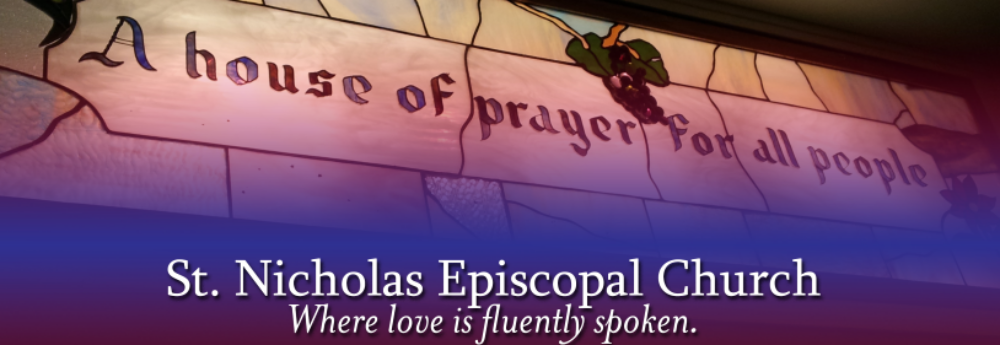
Elijah said to her,
“Do not be afraid;
go and do as you have said;
but first make me a little cake of it
and bring it to me,
and afterwards make something
for yourself and your son.
For thus says the LORD the God of Israel:
The jar of meal will not be emptied
and the jug of oil will not fail
until the day that the LORD
sends rain on the earth.”
— from the First Book of Kings

With the blessing — and help — of the Bishop’s Committee, I have been pursuing an opportunity to take a sabbatical next year. As some of you are aware, the Lilly Endowment has been strongly committed to promoting the wellbeing of churches. Our Diocese is one of many religious bodies across the country that has benefited from their interest in promoting mentoring of new clergy.
The Endowment also has for many years provided generous funding to congregations so that pastors may spend several months away from their congregations doing whatever it takes to make their “hearts sing” and renew them for service. The funding covers both the sabbatical activities of the pastor and additional costs incurred by the congregation during the pastor’s absence.
Our Diocese encourages clergy to take sabbaticals every five years, but that is difficult in many congregations because of funding obstacles. Many congregations do not have the funds to continue a priest’s salary while paying another priest to take over some of her or his duties during that time. And many clergy do not have personal funds to underwrite sabbatical activities such as travel. (This one certainly does not.)
Recognizing this situation exists across denominations and across the country, the Lilly Endowment’s program seeks to build stronger congregations by providing sabbatical funding that will help pastors be more spiritually healthy and creative, expecting that this will result in greater congregational health and creativity. Their approach makes sense. The catch is that the grants are highly competitive. Consequently, the Endowment seeks proposals that are creative and coherent, and give good evidence that they will make the clergy person’s “heart sing” and benefit his or her congregation. It’s a high bar, but I am hopeful.
I’ve spoken with a Lutheran pastor who received a grant several years ago — thanks to Ted Durst, for introducing us — and I am encouraged that we have a shot. Maybe a long shot, but a shot. In any event, the proposal we’ll soon submit is built around the theme of the Good Shepherd, which has been the central image of my ministry during the 15 years I’ve served St. Nicholas. I would be happy to answer any questions you have, or to talk more about sabbaticals, during the 10 a.m. hour the next several Sundays. In the meantime, I’d like to share with you the current draft of a “summary statement” for the proposal. Any feedback you have will be much appreciated.
A chance encounter with John Paul II more than 30 years ago provides the origin of this proposal. Fortuitously passing the cathedral when the new pope arrived during his 1979 visit to Washington, D.C., I felt immediately, irresistibly drawn to him and, although agnostic, stopped to listen as he celebrated Mass. Within minutes, I was in the throes of an emotional conversion, and within a few years, I had left my job and home to pursue a religious vocation. It was many years before I found language — a numinous experience of the Good Shepherd archetype (which bishops especially embody) – that helped me articulate what I experienced that Saturday.
As my vocation deepened, the Good Shepherd remained near. I was drawn to a statue of him at the monastery where I often went, and mesmerized in seminary at a lecture on shepherd and sheep given by one of my biblical professors. Involved in the early pastoral response to AIDS, I was angered by the lack of goodness many shepherds showed toward people with AIDS, as I was later by the way many bishops facilitated the sexual abuse of children. But I was enthralled by the Catechesis of the Good Shepherd and in awe of the work of many priests.
The shepherd image that grabbed me in 1979 has never really let go and it has been the anchoring image for my priesthood. St. Nicholas has become a “shepherding” congregation for many who have felt “lost:” persons in recovery from addiction, suburban gays, some interfaith families, and others marginalized by institutional religion. It has nurtured multiple calls to ordained ministry and significantly increased its outreach to the poor. During the past four years, we’ve also merged successfully with another congregation and completed a major building addition. After 15 years of shepherding, this sabbatical aims to make my heart sing by creating space and time for me to engage anew the numinous energy of the shepherd.
I will do this through travel, study, contemplation, and relaxation. I will travel to Italy to immerse myself in Good Shepherd imagery from the early church, visit a contemporary religious community that embodies the Good Shepherd, and see the tomb of Bishop Nicholas; to Auschwitz, for the shepherd cannot be understood apart from the wolf, and because my study of the Holocaust prepared in a paradoxical way for my conversion; and to Greece, to engage earlier shepherd images. I also will spend a week at a Benedictine monastery in New York which runs a sheep farm. At home, I will read literature on shepherd and sheep across disciplines, as well as meditate, exercise, and relax with my family.
— Steve


